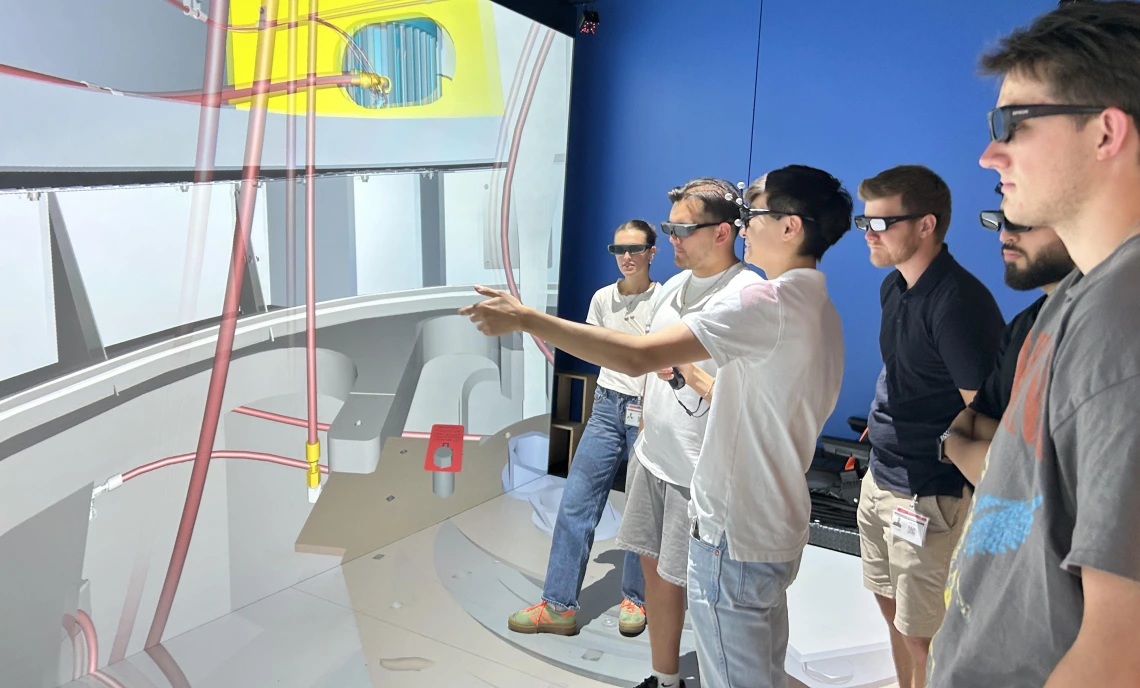Design reviews nurture growth and success for capstone seniors
‘We didn’t even think about that,’ says team leader of feedback that took his project to the next level.

Members of Team 25036 analyze a 3D model of a hydraulic mining shovel component in Caterpillar’s Virtual Reality Cave. Photo: David Rumph.
Seniors completing Interdisciplinary Capstone projects face two reviews at critical moments in their yearlong journeys to Craig M. Berge Design Day. During the preliminary and critical design reviews, conducted during the first semester of the capstone course, student teams present their projects to a panel of expert engineers, their team sponsor and faculty mentor.
“It’s arguably the most important part of the engineering design process,” said David Rumph, student leader for Team 25036. “It mimics real life.”
Students detail key project aspects like design concepts, trade-off decisions and analysis. Panelists raise questions and produce action items for teams to consider in their next stage of project development. The expert input helps teams make well-informed changes at the early and middle stages of their projects, setting them up for success come Design Day.
Solid advice
Rumph’s team is working with company sponsor Caterpillar on a hydraulic mining shovel. The students are redesigning the slew ring cover, a vital component that keeps essential lubrication grease meant for the shovel’s rotation axis from spilling out and being lost.
The shovel model they’re working with is capable of picking up 60 tons of material in one pass, so keeping the slew ring cover attached properly is a hefty task – one that requires the use of structural adhesives instead of welding. The team’s first choice for an adhesive proved ineffective, but thanks to feedback from the preliminary design review, the project was back on track in no time.
“The most important action item was to have an alternative adhesive after coming up with our primary one,” said Rumph, a mechanical engineering senior.
Working with the company 3M, the team chose not one but two adhesive alternatives. When Rumph and his teammates discovered that their third option was an even stronger alternative than their second, they made the change to their project.
“This idea to keep branching out and making sure to do your due diligence, do your research and find alternatives because you might just keep getting better was 100% right. We didn’t even think about that,” Rumph said. “We thought we had the end-all, be-all solution, so that was a great action item that they told us to look out for.”
’Aha!’ moments and shared knowledge
On the other side of the table, participating in design reviews is also a rewarding experience for panelists and sponsors. Lloyd Becker, senior design engineer at Caterpillar and sponsor for Team 25036, loves the process of brainstorming ideas with students and watching them learn along the way.
“It’s a great opportunity for the students to collaborate in real time and adapt their ideas based on feedback,” Becker said. “When you see that ‘Aha!’ moment, when they connect what they’re learning in school to real-world application – that piece of it is probably my favorite.”
The same feeling goes for Nicole Statler, a systems engineer at Raytheon, an RTX Business. The U of A engineering alum is a panelist whose memories of design reviews give her insight into what Design Day judges are looking for. She tries to pass on some of the same helpful feedback that she received when she was in their shoes.
“Ultimately, Design Day is the goal, so I try to help them make it less stressful,” said Statler, who graduated in 2022 with a BS in systems engineering.
And just like Becker, Statler relishes the opportunity to see students learn and grow.

